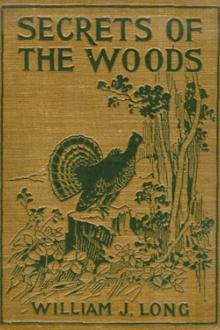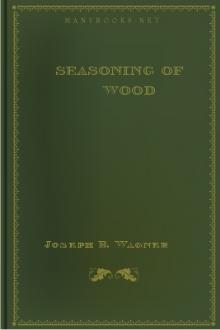Secret of the Woods by William J. Long (novels for students .TXT) 📕

- Author: William J. Long
- Performer: -
Book online «Secret of the Woods by William J. Long (novels for students .TXT) 📕». Author William J. Long
When traveling through the woods in deep snow, Keeonekh makes use of his sliding habit to help him along, especially on down grades. He runs a little way and throws himself forward on his belly, sliding through the snow for several feet before he runs again. So his progress is a series of slides, much as one hurries along in slippery weather.
I have spoken of the silver bubbles that first drew my attention to the fishing otters one day in the wilderness. From the few rare opportunities that I have had to watch them, I think that the bubbles are seen only after Keeonekh slides swiftly into the stream. The air clings to the hairs of his rough outer coat and is brushed from them as he passes through the water. One who watches him thus, shooting down the long slide belly-bump into the black winter pool, with a string of silver bubbles breaking and tinkling above him, is apt to know the hunter’s change of heart from the touch of Nature which makes us all kin. Thereafter he eschews trapping—at least you will not find his number-three trap at the foot of Keeonekh’s slide any more, to turn the shy creature’s happiness into tragedy—and he sends a hearty good-luck after his fellow-fisherman, whether he meet him on the wilderness lakes or in the quiet places on the home streams where nobody ever comes.
KOSKOMENOS THE OUTCASTKoskomenos the kingfisher is a kind of outcast among the birds. I think they regard him as a half reptile, who has not yet climbed high enough in the bird scale to deserve recognition; so they let him severely alone. Even the goshawk hesitates before taking a swoop at him, not knowing quite whether the gaudy creature is dangerous or only uncanny. I saw a great hawk once drop like a bolt upon a kingfisher that hung on quivering wings, rattling softly, before his hole in the bank. But the robber lost his nerve at the instant when he should have dropped his claws to strike. He swerved aside and shot upward in a great slant to a dead spruce top, where he stood watching intently till the dark beak of a brooding kingfisher reached out of the hole to receive the fish that her mate had brought her. Whereupon Koskomenos swept away to his watchtower above the minnow pool, and the hawk set his wings toward the outlet, where a brood of young sheldrakes were taking their first lessons in the open water.
No wonder the birds look askance at Kingfisher. His head is ridiculously large; his feet ridiculously small. He is a poem of grace in the air; but he creeps like a lizard, or waddles so that a duck would be ashamed of him, in the rare moments when he is afoot. His mouth is big enough to take in a minnow whole; his tongue so small that he has no voice, but only a harsh klr-rr-r-ik-ik-ik, like a watchman’s rattle. He builds no nest, but rather a den in the bank, in which he lives most filthily half the day; yet the other half he is a clean, beautiful creature, with never a suggestion of earth, but only of the blue heavens above and the color-steeped water below, in his bright garments. Water will not wet him, though he plunge a dozen times out of sight beneath the surface. His clatter is harsh, noisy, diabolical; yet his plunge into the stream, with its flash of color, its silver spray, and its tinkle of smitten water, is the most musical thing in the wilderness.
As a fisherman he has no equal. His fishy, expressionless eye is yet the keenest that sweeps the water, and his swoop puts even the fish-hawk to shame for its certainty and its lightning quickness.
Besides all these contradictions, he is solitary, unknown, inapproachable. He has no youth, no play, no joy except to eat; he associates with nobody, not even with his own kind; and when he catches a fish, and beats its head against a limb till it is dead, and sits with head back-tilted, swallowing his prey, with a clattering chuckle deep down in his throat, he affects you as a parrot does that swears diabolically under his breath as he scratches his head, and that you would gladly shy a stone at, if the owner’s back were turned for a sufficient moment.
It is this unknown, this uncanny mixture of bird and reptile that has made the kingfisher an object of superstition among all savage peoples. The legends about him are legion; his crested head is prized by savages above all others as a charm or fetish; and even among civilized peoples his dried body may still sometimes be seen hanging to a pole, in the hope that his bill will point out the quarter from which the next wind will blow.
But Koskomenos has another side, though the world as yet has found out little about it. One day in the wilderness I cheered him quite involuntarily. It was late afternoon; the fishing was over, and I sat in my canoe watching by a grassy point to see what would happen next. Across the stream was a clay bank, near the top of which a hole as wide as a tea-cup showed where a pair of kingfishers had dug their long tunnel. “There is nothing for them to stand on there; how did they begin that hole?” I wondered lazily; “and how can they ever raise a brood, with an open door like that for mink and weasel to enter?” Here were two new problems to add to the many unsolved ones which meet you at every turn on the woodland byways.
A movement under the shore stopped my wondering, and the long lithe form of a hunting mink shot swiftly up stream. Under the hole he stopped, raised himself with his fore paws against the bank, twisting his head from side to side and sniffing nervously.
“Something good up there,” he thought, and began to climb. But the bank was sheer and soft; he slipped back half a dozen times without rising two feet. Then he went down stream to a point where some roots gave him a foothold, and ran lightly up till under the dark eaves that threw their shadowy roots over the clay bank. There he crept cautiously along till his nose found the nest, and slipped down till his fore paws rested on the threshold. A long hungry sniff of the rank fishy odor that pours out of a kingfisher’s den, a keen look all around to be sure the old birds were not returning, and he vanished like a shadow.
“There is one brood of kingfishers the less,” I thought, with my glasses focused on the hole. But scarcely was the thought formed, when a fierce rumbling clatter sounded in the bank. The mink shot out, a streak of red showing plainly across his brown face. After him came a kingfisher clattering out a storm of invective and aiding his progress by vicious jabs at his rear. He had made a miscalculation that time; the old mother bird was at home waiting for him, and drove her powerful beak at his evil eye the moment it appeared at the inner end of the tunnel. That took the longing for young kingfisher all out of Cheokhes. He plunged headlong down the bank, the bird swooping after him with a rattling alarm that brought another kingfisher in a twinkling. The mink dived, but it was useless to attempt escape in that way; the keen eyes above followed his flight perfectly. When he came to the surface, twenty feet away, both birds were over him and dropped like plummets on his head. So they drove him down stream and out of sight.
Years afterward I solved the second problem suggested by the kingfisher’s den, when I had the good fortune, one day, to watch a pair beginning their tunneling. All who have ever watched the bird have, no doubt, noticed his wonderful ability to stop short in swift flight and hold himself poised in midair for an indefinite time, while watching the movements of a minnow beneath. They make use of this ability in beginning their nest on a bank so steep as to afford no foothold.
As I watched the pair referred to, first one then the other would hover before the point selected, as a hummingbird balances for a moment at the door of a trumpet flower to be sure that no one is watching ere he goes in, then drive his beak with rapid plunges into the bank, sending down a continuous shower of clay to the river below. When tired he rested on a watch-stub, while his mate made a battering-ram of herself and kept up the work. In a remarkably short time they had a foothold and proceeded to dig themselves in out of sight.
Kingfisher’s tunnel is so narrow that he cannot turn around in it. His straight, strong bill loosens the earth; his tiny feet throw it out behind. I would see a shower of dirt, and perchance the tail of Koskomenos for a brief instant, then a period of waiting, and another shower. This kept up till the tunnel was bored perhaps two feet, when they undoubtedly made a sharp turn, as is their custom. After that they brought most of the earth out in their beaks. While one worked, the other watched or fished at the minnow pool, so that there was steady progress as long as I observed them.
For years I had regarded Koskomenos, as the birds and the rest of the world regard bim, as a noisy, half-diabolical creature, between bird and lizard, whom one must pass by with suspicion.
But that affair with the mink changed my feelings a bit.
Koskomenos’ mate might lay her eggs like a reptile, but she could defend them like any bird hero. So I took to watching more carefully; which is the only way to get acquainted.
The first thing I noticed about the birds—an observation confirmed later on many waters—was that each pair of kingfishers have their own particular pools, over which they exercise unquestioned lordship. There may be a dozen pairs of birds on a single stream; but, so far as I have been able to observe, each family has a certain stretch of water on which no other kingfishers are allowed to fish. They may pass up and down freely, but they never stop at the minnow pools; they are caught watching near them, they are promptly driven out by the rightful owners.
The same thing is true on the lake shores. Whether there is some secret understanding and partition among them, or whether (which is more likely) their right consists in discovery or first arrival, there is no means of knowing.
A curious thing, in this connection, is that while a kingfisher will allow none of his kind to poach on his preserves, he lives at peace with the brood of sheldrakes that occupy the same stretch of river. And the sheldrake eats a dozen fish to his one.
The same thing is noticeable among the sheldrakes also, namely, that each pair, or rather each mother and her brood, have their own piece of lake or river on. which no others are allowed to fish. The male sheldrakes meanwhile are far away, fishing on their own waters.
I had not half settled this matter of the division of trout streams when another observation came,





Comments (0)